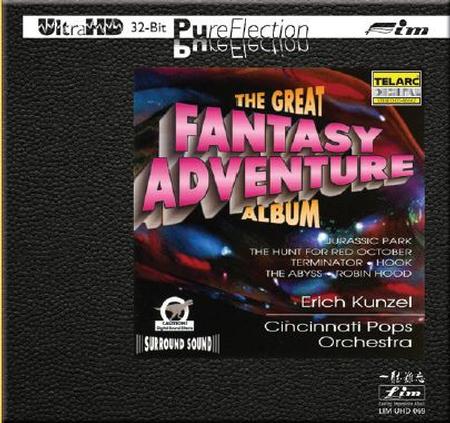
Tracklist:
1. El Cid: Fanfare And Entry Of The Nobles
2. Hook: Main Themes
3. T. Rex! (SFX)
4. Jurassic Park: Main Themes
5. Splitting Hairs (SFX)
6. Robin Hood: Main Titles
7. Henry V: Opening And Closing Titles
8. Willow: Main Themes
9. The Seventh Voyage Of Sinbad: Overture
10. The Abyss: End Titles
11. Clash Of The Titans: Main Titles, Love Theme, And End Titles
12. The Rocketeer: To The Rescue And End Titles
13. Bettlejuice: Main Titles
14. Total Recall: Main Titles
15. The Princess Bride: Main Titles
16. Wizards And Warriors: Main Titles
17. Conan The Barbarian: Anvil Of Crom
18. The Hunt For Red October: Hymn To Red October
19. Cybergenesis (SFX)
20. Terminator: Theme
21. Jurassic Lunch (SFX)
Ultra High Definition 32-Bit Mastering!
Ultra High Definition 32-Bit Mastering is a proprietary ultra-high-quality mastering system. This leading-edge system has achieved unprecedented sonority and musicality, reproducing as closely as possible the sound of the original master tape! This format employs what is currently the highest attainable resolution bit depth (word length) in the professional audio field, i.e. 32-bit. 32-bit resolution makes possible maximized, undistorted dynamics, and the lowest noise floor, allowing even the quietest musical information to be heard more clearly. This breakthrough results from the development, through years of experience and application of advanced digital technology, of a sophisticated A/D and D/A processing system.
Ultra HD 32-Bit Mastering does not specify a sampling rate; this allows flexibility in meticulously choosing the appropriate bandwidth for a particular recording. The higher the sampling rate — for example, 192 kHz — the greater the bandwidth. However, merely employing the greatest bandwidth may not guarantee the ultimate sound. With some recordings, a lower sampling rate — 96 or 176 kHz — may offer better musicality and more homogeneous harmonics. This determination requires careful and discerning auditioning and professional judgment. In the end, the human being�s hearing and emotions should be the final arbiter, rather than the print-out of testing equipment or technical measurements.
Recognizing these variables, FIM nevertheless tries to use 32-bit depth and 192 kHz bandwidth whenever the original analog master is at hand. Alternatively, if the original recording is on 24/96, the 32/96 may eventually be used to maintain the integrity of the sonority particular to that recording. With this flexibility, First Impression Music believes that preeminent sound is only achievable when the chemistry of the recording, mastering, glass-stamper making, replication, and quality control is right. As always, listening is believing.
This recording has been mastered by the new Ultra High Definition 32-Bit Mastering process, which creates an unbelievable sound surpassing other formats!
Erich Kunzel conducts the Cincinnati Pops Orchestra for selections from the films Jurassic Park, The Hunt For Red October, Terminator, Hook, The Abyss, and Robin Hood.
Over the years, Michael Bishop’s sound effects, included on many of the Cincinnati Pops recordings, gave a special character to those CDs, enhancing the "themes" of the recordings and delighting listeners with their realism.
The lion and tiger roars used in various recordings, (including one of the many sound layers for T-Rex on the award-winning Great Fantasy Adventure Album) were made on location in the lions’ den and tigers’ cages of the Cleveland Metroparks Zoo.
"Recording the lion roars was a memorable experience," says Bishop. He recalls having had the intuition to start his recorders running prior to arriving at the zoo’s "cathouse," in the morning before they opened to the public. The lions, says Bishop, were docile until he set foot inside their "house" at which point they went crazy, roaring and jumping all over the place. "I was able to record some ferocious roars that day," he says. Those roars were eventually mixed, along with recordings of whinnies from Bishop’s twenty-four year-old Arabian horse, Ricky, to form the bone-chilling beasts heard.
The benefits of Ultra HD 32-Bit Mastering:
� Ambience of Analogue Sound
� Higher Resolution
� Undistorted Dynamics
� The Lowest Noise Floor, allowing even the quietest musical information to be heard more clearly!
� Richer Sound Field
� Master-Tape Quality Sound!!!
� Delivers what musicians originally intended!
Features:
� Limited Run of Only 2,000 First Edition Pressings Available!
� Produced using PureFlection (Pure Reflection) Process
� Ultra HD Mastering
� Beautifully packaged
� Playable on ALL CD Players!
� Re-mastered by Michael Bishop at Five/Four Productions, Ohio, USA
Marketing waffle or not? You be the judge…
PM for Link
After 2 + 2 listenings, I still can’t decide which version is better.
Then by that rationale, the smallest file size is sufficient. Also the lowest bit depth and sample rate.
The lowest quality achieved appears to be transparent to the highest quality achieved.
With this logic, it is sane (and safe) to grab the lowest one and live with that if you plan to only listen to.
I would grab the sfx in highest possible, however, for editing or insane compression (say, ogg format for video games).
However, the sample rate (although wider bandwidth) is also very incompatible with most commonly used encoders.
A sample rate conversion is required and that’s a whole new field.
Having said that, and knowing I love to edit (and with extreme consequences), I’ll grab the bestest version. 😀
Thanks for the share. Looking forward to the sfx.
———- Post added at 08:49 PM ———- Previous post was at 08:34 PM ———-
Oh wait! The file sizes are near identical.
Implying the final files are same bit depth/sample rate.
Other insufficient information: lack of bit depth specification (integer or float?) and if any dithering was applied on the downscaling to 16bit.
I wouldn’t worry too much about the Sample Rate Conversion process as I believe they would use something "clean" for it.
At those levels, theoretically, the difference should be very minimal.
24bit already provides adequate details for editing. The same is generally for the sample rate. Anything higher than 48KHz is quite sufficient for editing/mastering.
While the article is correct in preserving the most, the difference is very marginal.
Ultimately, they’re both 16bit/44.1KHz so for us, it’s kind of wafflely.
However, if they wanted to create a 44.1KHz product, upscaling to a multiple of 44.1 would be more mathematically sane: 44.1, 88.2, 132.2, 176.4, 220.5 (although most go as high as 192 only which is visible by 48).
However, if this is a first-time grab, I would go with this remastered version.
Great album
Still, for a future where real HD audio will be standard, we already have something to test on it… thanks, mr. merrick! 🙂
As regards the remastering, the ORIGINAL version of this album is vastly superior (endless thanks for uploading both) – the "remastering" constitutes nothing but a massive crushing of dynamic range – another victim of the insidious loudness war.
As for the recording itself, well, it’s pretty much redundant now… Still a fascinating historical artefact, but I won’t be giving up the original recordings to listen to these.
The awful keyboard synth in The Abyss! Dear God! My ears! The earplugs do nothing! (With apologies to McBain.)
Bit-depths above 16bit and sample rates above 44.1khz already represent sound to well-beyond the human hearing spectrum.
It is beneficial to use them during editing and restoration, but serves no difference for distribution.
Scott
See this: On top the new master, beneath the old.
But thanks for sharing both!
Thank you for sharing 🙂








